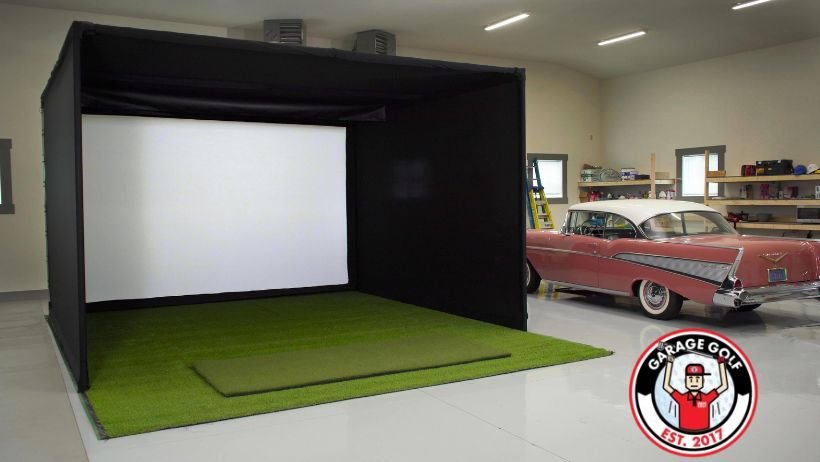
Golf, a game of precision and passion, has taken a new turn with the advent of golf simulators. It’s now simpler than ever to create a unique space in your own home or business to perfect your swing and enjoy the game thanks to these high-tech wonders that let you tee off from the convenience of your home or even a golf simulator facility. But how do you pick the ideal golf simulator for your requirements when so many options are available? In this article, we’ll examine the essential elements to take into account while picking the best golf simulator for you.
1. Space and Location
The available location and space greatly influence your choice of golf simulator. Consider width and height when measuring the space where you intend to place the simulator. Ceiling height is quite important, particularly if you want to practice all different golf shots, such as driver shots that need higher overhead clearance. Typically we recommend a minimum of 9’ of height in regards to your ceiling to swing a driver, but 10’ feet is ideal for most people. Ensure the simulator can be placed in the given area without feeling crowded.
2. Budget
When looking for a golf simulator, having a clear budget is crucial. Prices might vary dramatically from budget-friendly selections to high-end versions with cutting-edge features. Choose your budget range, considering that a larger budget frequently corresponds to greater accuracy and more features. You can reduce your options and pick the finest simulator for your needs by using your budget. We can and have worked with people of all different budgets and space requirements so don’t hesitate to reach out to us today.
3. Simulator Type (Launch Monitor Selection)
Launch monitor-based and camera-based golf simulators are the two main categories.
Radar-Based Launch Monitors
Radar-based golf launch monitors work by emitting radio waves that bounce off the moving golf ball and return to the monitor’s sensors. As the ball moves, it causes a change in the frequency of the reflected waves, known as the Doppler effect. The monitor then analyzes these frequency shifts to calculate various metrics about the golf shot. These metrics can include ball speed, launch angle, spin rate, and carry distance, among others. By analyzing this data, golfers can gain insights into their swing and make necessary adjustments to improve their game. Radar based launch monitors tend to work better outside and often have longer depth requirements for space when using indoors.
Camera-Based Launch Monitors
Camera-based golf launch monitors utilize high-speed cameras to capture multiple images of the golf ball immediately after impact. By analyzing the trajectory, rotation, and speed of the ball in these images, the system can calculate various shot metrics. These metrics can include ball speed, launch angle, spin rate, and carry distance, among others. The high frame rate of the cameras ensures precise data capture, allowing golfers to gain detailed insights into their swing and ball flight. This information is then processed by software to provide feedback, helping golfers refine their technique and improve their game. Camera based launch monitors often work well inside and require less space and overall depth that radar based launch monitors require.
4. Accuracy and Precision
In a golf simulator, precision and accuracy are essential. Look for a simulator that offers accurate information on your swing and shot, including the ball’s trajectory, the clubface angle, shot dispersion, and spin rates. The more precise the simulator, the better your ability to evaluate your performance and make the required changes to enhance your game. Precision and price don’t always go hand in hand. There are several entry level golf launch monitor options that work quite well even compared to higher end launch monitors but sometimes the trade-off there is that they don’t collect as many data points. For many average golfers, that trade off is often worth the difference in price.
5. Software and Course Selection
Analyze the simulator’s available and integral golf simulation software. It must provide access to a sizable collection of virtual golf courses, all of which should be created with excellent graphics and accurate layouts. If the integral golf simulation software does not meet this needs, it should be a requirement that the launch monitor you are selecting offers the ability to play third party software on their device. Good examples of third party software would include programs such as GSPRO, E6 Connect, TGC 2019, Awesome Golf and others. Consider the software’s adjustable practice modes, which may be tailored to different skill levels and specific areas for development. A software bundle with lots of features improves your entire simulator experience.
6. Ease of Installation and Use
A golf simulator’s usability and ease of installation are important features. Verify that the simulator you are considering has simple installation instructions and a user-friendly interface. A user-friendly simulator streamlines the procedure, allowing you to concentrate on your game instead of a complex setup that may be annoying and time-consuming.
7. Portability
Portability is crucial for some people with limited space or who want the freedom to move their simulator setup when not in use. Some simulators are made to be portable and light, which makes them simpler to set up when needed for either parking in a garage or when a person wants to travel with their setup. Portability can be extremely useful if you want to use the simulator in various locations but will not be a requirement for all people.
8. Additional Features
Investigate any other features the simulator provides. A few versions include useful extras like swing analysis tools that offer thorough feedback on your swing mechanics. Others let you play online games with friends or family in a multiplayer mode. Whatever extra features you might be looking for, make sure to reach out to us first to see what options are available and which would best suit your needs and budget.
9. Customer Reviews and Support
Read consumer reviews and comments about the simulator you’re considering before making your final decision. Real-world user feedback can offer insight into functionality, dependability and general satisfaction levels of users. Additionally, find out if the launch monitor company offers dependable customer service. Customer service that responds quickly might be beneficial if there are any problems or inquiries. We also offer customer support to any clients we assist throughout their golf simulation build.
10. Guarantee
When buying a golf simulator, the warranty is quite essential. If there are flaws or breakdowns, it provides confidence and peace of mind. For proper protection of your investment, carefully evaluate the warranty terms and coverage offered by the manufacturer. A strong warranty may significantly influence your decision-making process. Many companies offer an minimum 1 year manufacturer warranty but when purchasing items through resellers like The Indoor Golf Shop there are also often times where an extended warranty or accident protection warranty can be provided at an additional cost.
In Conclusion
When choosing an ideal golf simulator, carefully examining your tastes, space, and financial situation is important. You can make a choice that guarantees a pleasurable and productive experience by weighing these factors and investigating other facets of your build. The correct golf simulator may be a valuable addition to your golf game, whether you’re an experienced player trying to improve your techniques or a novice player eager to learn.
As always with any questions please reach out to us directly here at Garage Golf either via email at Roland@MyGarageGolf.com or via phone anytime at 210-643-6954. We look forward to assisting you with all your golf simulator needs.
